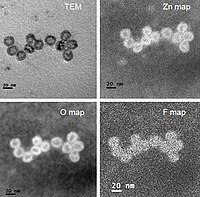
Photo from wikipedia
Chiral semiconductor nanomaterials induced by capped chiral ligands are of great interest for both theoretical studies and advanced applications. In this study, CdTe/CdSe quantum dots (QDs), defined as type-II core/shell… Click to show full abstract
Chiral semiconductor nanomaterials induced by capped chiral ligands are of great interest for both theoretical studies and advanced applications. In this study, CdTe/CdSe quantum dots (QDs), defined as type-II core/shell nanostructure, with the advantage of a good separation of holes and electrons are imparted chirality with L/D-cysteine and L/D-penicillamine molecules. Circular dichroism (CD) at exciton transitions from cysteine- and penicillamine-capped QDs is different in shape and intensity. CD intensities decrease with increasing shell thickness from three monolayers to six monolayers, indicating a decreased hybridization degree between the holes in CdTe core and the electrons in chiral ligands. Elevated cysteine concentration leads to decreased g-factor, probably due to an altered binding mode from tridentate to bidentate. Our observations provide further insights into the understanding of chiral phenomenon as well as optimized design and applications of chiral nanostructures.
Journal Title: Chirality
Year Published: 2021
Link to full text (if available)
Share on Social Media: Sign Up to like & get
recommendations!